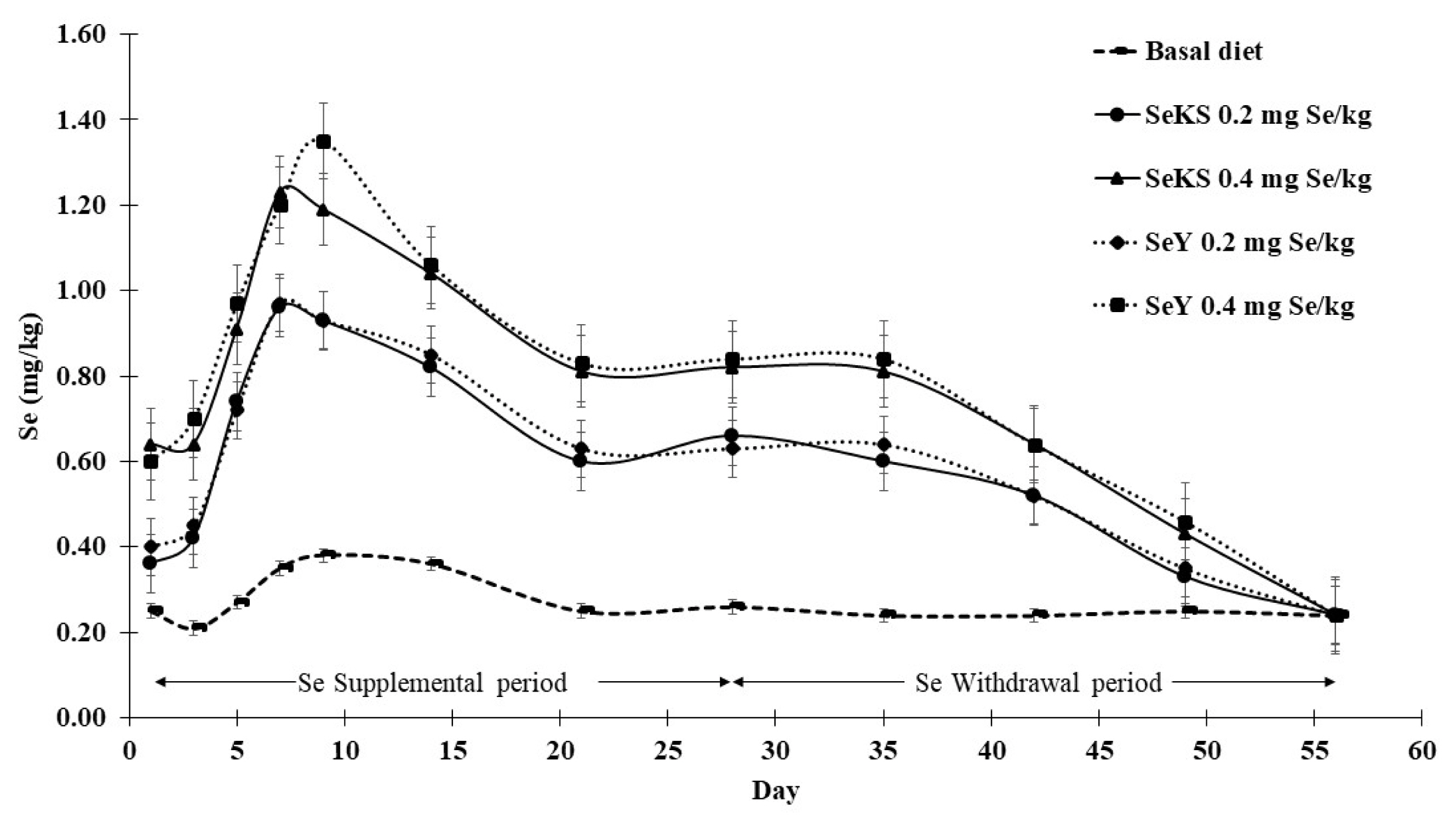3. Chantiratikul A, Aengwanich W, Chinrasri O, Chantiratikul P. Plasma selenium concentration and glutathione peroxidase activity in red blood cell of laying hens fed sodium selenite or zinc-L-selenomethionine. Int J Poult Sci 2008; 7:692–5.
4. Gjorgovsky N, Kiril F, Vesna L, Tosho K. The effect of different levels of selenium in feed on egg production, egg quality and selenium content in yolk. Lucrări Ştiinţifice–Seria Zootehnie 2012; 57:270–4.
7. Fisinin VI, Papazyan TT, Surai PF. Producing specialist poultry products to meet human nutrition requirements: selenium enriched eggs. World’s Poult Sci J 2008; 64:85–98.
https://doi.org/10.1017/S0043933907001742

8. Chinrasri O, Chantiratikul P, Thosaikham W, et al. Effect of selenium-enriched bean sprout and other selenium sources on productivity and selenium concentration in eggs of laying hens. Asian-Australas J Anim Sci 2009; 22:1661–6.
https://doi.org/10.5713/ajas.2009.90220

9. Jiakui L, Xiaolong W. Effect of dietary organic versus inorganic selenium in laying hens on the productivity, selenium distribution in egg and selenium content in blood, liver and kidney. J Trace Elem Med Biol 2004; 18:65–8.
https://doi.org/10.1016/j.jtemb.2004.04.002


10. Chantiratikul A, Chinrasri O, Chantiratikul P, Noochangsing A, Channarong S, Thosaikham W. Selenium enrichment in sprouts of sunflower (Helianthus annuus). Agric Nat Res 2019; 53:608–11.
https://doi.org/10.34044/j.anres.2019.53.6.07

11. Maneetong S, Chookhampaeng S, Chantiratikul A, et al. Hydroponic cultivation of selenium-enriched kale (Brassica oleracea var. alboglabra L.) seedling and speciation of selenium with HPLC–ICP-MS. Microchem J 2013; 108:87–91.
https://doi.org/10.1016/j.microc.2013.01.003

12. Chinrasri O, Chantiratikul P, Maneetong S, Chookhampaeng S, Chantiratikul A. Productivity and selenium concentrations in egg and tissue of laying quails fed selenium from hydroponically produced selenium-enriched kale sprout (Brassica oleracea var. alboglabra L.). Biol Trace Elem Res 2013; 155:381–6.
https://doi.org/10.1007/s12011-013-9824-3


13. Chantiratikul A, Pakmaruek P, Chinrasri O, et al. Efficacy of selenium from hydroponically produced selenium-enriched kale sprout (Brassica oleracea var. alboglabra L.) in broilers. Biol Trace Elem Res 2015; 165:96–102.
https://doi.org/10.1007/s12011-015-0227-5


14. Chantiratikul A, Chinrasri O, Chantiratikul P. Effect of selenium from selenium-enriched kale sprout versus other selenium sources on productivity and selenium concentrations in egg and tissue of laying hens. Biol Trace Elem Res 2018; 182:105–10.
https://doi.org/10.1007/s12011-017-1069-0


15. Leamsamrong K, Tongjaroenbuangam W, Maneetong S, Chantiratikul A, Chinrasri O, Chantiratikul P. Physicochemical contents, antioxidant activities, and acute toxicity assessment of selenium-enriched Chinese kale (Brassica oleracea var. alboglabra L.) seedlings. J Chem. 2019. 2019:Article ID 7983038.
https://doi.org/10.1155/2019/7983038

16. Chantiratikul A, Borisuth L, Chinrasri O, et al. Evaluation of the toxicity of selenium from hydroponically produced selenium-enriched kale sprout in laying hens. J Trace Elem Med Biol 2016; 35:116–21.
https://doi.org/10.1016/j.jtemb.2016.02.007


17. Luang-In V, Saengha W, Buranrat B, Chantiratikul A, Ma NL. Cytotoxicity of selenium-enriched Chinese kale (Brassica oleracea var. alboglabra L.) seedlings against Caco-2, MCF-7 and HepG2 cancer cells. Pharmacogn J 2020; 12:674–81.
https://doi.org/10.5530/pj.2020.12.99

19. Chantiratikul A, Chinrasri O, Chantiratikul P. Effect of sodium selenite and zinc-L-selenomethionine on performance and selenium concentrations in eggs of laying hens. Asian-Australas J Anim Sci 2008; 21:1048–52.
https://doi.org/10.5713/ajas.2008.70576

21. National Research Council. Nutrition requirement of poultry. 9thedWashington, DC, USA: National Academy Press; 1994.
22. Seo TC, Spallholz JE, Yun HK, Kim SW. Selenium-enriched garlic and cabbage as a dietary selenium source for broilers. J Med Food 2008; 11:687–92.
https://doi.org/10.1089/jmf.2007.0053


24. AOAC International. Official methods of analysis of the AOAC International. 16th edArlington, VA, USA: AOAC International; 1999.
25. SAS Institute. SAS/STAT user’s guide: release 6.03 ed. Cary, NC, USA: SAS Institute Inc; 1996.
26. Jing CL, Dong XF, Wang ZM, Lui S, Tong JM. Comparative study of DL-selenomethionine vs sodium selenite and seleno-yeast on antioxidant activity and selenium status in laying hens. Poult Sci 2015; 94:965–75.
https://doi.org/10.3382/ps/pev045


27. Lu J, Qu L, Shen MM, et al. Comparison of dynamic change of egg selenium deposition after feeding sodium selenite or selenium-enriched yeast. Poult Sci 2018; 97:3102–8.
https://doi.org/10.3382/ps/pey161


28. Lu J, Qu L, Shen MM, et al. Effect of high-dose selenium-enriched yeast on laying performance, egg quality, clinical blood parameters, organ development, and selenium deposition in laying hens. Poult Sci 2019; 98:2522–30.
https://doi.org/10.3382/ps/pey597


29. Han XJ, Qin P, Li WX, et al. Effect of sodium selenite and selenium yeast on performance, egg quality, antioxidant capacity, and selenium deposition of laying hens. Poult Sci 2017; 96:3973–80.
https://doi.org/10.3382/ps/pex216


30. Meng T, Liu Y, Wie C, et al. Effects of different selenium sources on laying performance, egg selenium concentration, and antioxidant capacity in laying hens. Biol Trace Ele Res 2019; 189:548–55.
https://doi.org/10.1007/s12011-018-1490-z

31. Ljali M, Briens M, Rouffineau F, Mercerand F, Geraert PA, Mercier Y. Effect of 2-hydroxy-4-methylselenobutanoic acid as a dietary selenium supplement to improve the selenium concentration of table eggs. J Anim Sci 2013; 91:1745–52.
https://doi.org/10.2527/jas.2012-5825


32. Radwan NL, Salah Eldin TA, El-Zaiat AA, Mostafa MSA. Effect of dietary nano-selenium supplementation on selenium content and oxidative stability in table eggs and productive performance of laying hens. Int J Poult Sci 2015; 14:161–76.

36. Latshaw JD, Osman M. Distribution of selenium in egg white and yolk after feeding natural and synthetic selenium compounds. Poult Sci 1975; 54:1244–52.
https://doi.org/10.3382/ps.0541244


38. Payne RL, Lavergne TK, Southern LL. Effect of inorganic versus organic selenium on hen production and egg selenium concentration. Poult Sci 2005; 84:232–7.
https://doi.org/10.1093/ps/84.2.232











 PDF Links
PDF Links PubReader
PubReader ePub Link
ePub Link Full text via DOI
Full text via DOI Download Citation
Download Citation Print
Print





